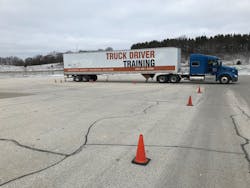I kept an eye on the forecast for that Monday morning. My test time was scheduled for 11:30 AM, but I needed to be present about two hours ahead of time in case they were ready for me any earlier. (e.g. the student before me failed some portion of his or her test.)
I was nervous, I was anxious. I was properly caffeinated. And, I was ready.
Pre-trip inspection
For the pre-trip inspection portion, I could name (nearly) every component, tell you where to find it, what I was looking for in the event of an issue, and what it did.
I ended up getting the "A" test, which means I covered the engine compartment of the tractor. I was still required to provide details on the safety equipment, the coupling device, conduct a light check, check in-cab gauges and dash, and perform the air brake LABS test.
(Read more about the full process for pre-trip inspections.)
The key here is that you need to essentially "educate" the tester on what you're reviewing and why.
My tester, Lynn Kutchman, a 40-plus year veteran in the industry and safety fanatic, stressed the importance of being safe on the road. That starts with understanding how to complete a thorough pre-trip inspection. I liked this guy already.
Before retiring, Lynn worked as a logistics manager at Brenntag, a chemical hauler. I learned that Lynn had experience in many aspects of the commercial vehicle industry, with a background in driving, warehouse operations and managing the maintenance department.
I understood Lynn's focus on safety: when you're hauling dangerous chemicals, you don't want them sloshing everywhere. I appreciated his thoroughness and attention to detail.
Score: 45 out of 48. I missed the air and electrical lines for the coupling device. While practicing pre-trip over the last several weeks, I've always done the air line checks when reviewing the side of the tractor; so I hadn't associated them with the coupling device. It was my one major oversight - I cursed getting a partial instead of full-vehicle pre-trip. (I also missed checking the vehicle frame when covering under the hood.)
Backing
For backing, you're allotted 12 points before it's a fail. Well I took full advantage of those points, let me tell you.
Straightline? No problem. Offset? I used my two pull-ups and hit my mark. But, my nemesis nearly cost me: the 90-degree back.
The setup is critical, but it's not the end of the world if you come in too wide or short. It's the pull-up once you realize your mistake that can make or break you.
After hours of practice, I felt confident I could correct an inaccurate setup. Any other day, maybe. For the test, I ended up too short, aiming straight for the inside cones. I pulled to the left and up. Once, twice... a third time. A fourth time. By my fifth pull-up I was frustrated, and out of room at my boundary line. (Which Lynn let me know about each time he raised his arm when I got too close to the boundary line cones.) I pulled up a sixth time, a seventh time. An eighth time. I stopped and came to grips with the fact that I just might have to start this whole test thing over another day.
At this point, unaware the far boundary isn't actually a point deduction, I figured Lynn was just going to let me continue my pull-ups for the afternoon without letting me know I actually failed the test and could go home.
Finally, exacerbated and nearly giving up, I looked out my window, and opted to pull as close to the position I'd started at the beginning of this entire ordeal. I put it in first gear, cranked the steering wheel to the left, then straightened out. My ninth pull-up. My trailer was facing the opposite direction of the 90-degree parking space. At least I wasn't as close to the boundary line. May as well end on a high note with a blindside back, I thought.
Somehow, though, I turned the steering wheel just the right amount to get into the stall. My trailer was straight, about five feet from the back of the stall, but my tractor was skewed to the left. Not straight, not passing. I'd need to pull up again.
I cut the engine, grabbed the keys and got out to look. (Still had two "G.O.A.L.s" left...) I checked out how far back I needed to get my trailer to finish, but also looked at Lynn. "So, have I failed yet?" He said, "You've got one more point. Don't lose it."
Resolved to not mess this up, I got back in the cab. Pulled forward for a simple straightline, and ... nailed it.
Score: 11 out of 12. All pull-ups, all the time. That 90-degree nearly cost me.
Road test
For the pre-trip inspection and backing portions of the test, you have some semblance of control. You can study and practice. While on the road you have the opportunity to practice throughout the class as well, there are a number of additional variables you must account for and may have to react to when driving: weather, hazards, construction, erratic or inattentive drivers, oblivious pedestrians, etc.
I had confidence in my ability to shift and handle turns going into the tests that morning. But, after the backing fiasco that nearly cost me the test, I was a little shook.
After the backing test, I had asked to take a short break - regaining my chi, etc. and all that - before getting behind the wheel for the road test portion.
It took a few minutes, but once we were on the road I ignored the fact that I was being tested. I kept telling myself it was the same as any other road day in class over the last several weeks. With my tester, Lynn, providing instructions for upcoming turns with enough time, coupled with the familiarity of the roads we were driving after driving them so frequently the last several weeks, I felt comfortable.
There were no erratic drivers or crazy pedestrians. It was a simple loop of familiar roads and a short drive on the highway before returning to campus. I pulled the tractor-trailer into the lot and parked, letting out the biggest sigh of relief.
Lynn confirmed I passed, congratulating me on the low score for the driving demonstration. I was officially eligible to become a commercial driver's license holder.
Score: 8 out of 30. A few items here, but nothing critical: The two main items involved not turning on a covered arrow that turned yellow at the wrong time; and losing my gear for about 100 feet downshifting for a right-hand turn, which I recovered from 7th down to 4th.
Follow-up
Over the course of two days of testing, six of the 14 students passed on the first attempt. Many struggled with backing, a few others with the road test (with bumped curbs, mostly). Test anxiety is no joke, and students have the opportunity to retake the portion of the test they failed on and continue from there. Nerves can get the best of you (which almost cost me for the backing). That's why it's not a one-and-done deal. Students can and do take the test again where they left off. Of those who failed at one portion, nearly all of my classmates passed the second time through.
...
In the Driver’s Seat is a blog series from Fleet Maintenance editor-in-chief Erica Schueller. The series covers the process of attending a formalized technical training professional truck driving program in order to obtain a Class commercial vehicle driver’s license.
About the Author
Erica Schueller
Media Relations Manager | Navistar
Erica Schueller is the Media Relations Manager for Navistar.
Before joining Navistar, Schueller served as Editorial Director of the Endeavor Commercial Vehicle Group. The commercial vehicle group includes the following brands: American Trucker, Bulk Transporter, Fleet Maintenance, FleetOwner, Refrigerated Transporter, and Trailer/Body Builders brands.
An award-winning journalist, Schueller has reported and written about the vehicle maintenance and repair industry her entire career. She has received accolades for her reporting and editing in the commercial and automotive vehicle fields by the Truck Writers of North America (TWNA), the International Automotive Media Competition (IAMC), the Folio: Eddie & Ozzie Awards and the American Society of Business Publication Editors (ASBPE) Azbee Awards.
Schueller has received recognition among her publishing industry peers as a recipient of the 2014 Folio Top Women in Media Rising Stars award, acknowledging her accomplishments of digital content management and assistance with improving the print and digital products in the Vehicle Repair Group. She was also named one Women in Trucking’s 2018 Top Women in Transportation to Watch.
She is an active member of a number of industry groups, including the American Trucking Associations' (ATA) Technology & Maintenance Council (TMC), the Auto Care Association's Young Auto Care Networking Group, GenNext, and Women in Trucking.
In December 2018, Schueller graduated at the top of her class from the Waukesha County Technical College's 10-week professional truck driving program, earning her Class A commercial driver's license (CDL).
She has worked in the vehicle repair and maintenance industry since 2008.

